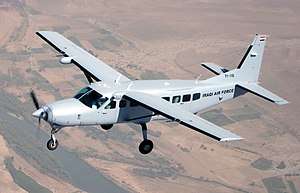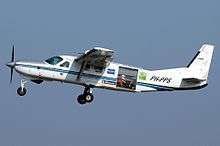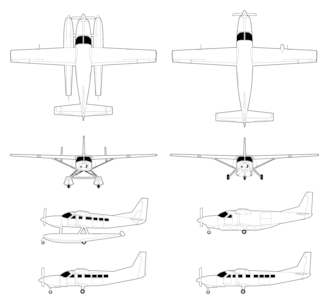Cessna 208 Caravan
The Cessna 208 Caravan is a utility aircraft produced by Cessna. The project was commenced on November 20, 1981, and the prototype first flew on December 9, 1982. The production model was certified by the FAA in October 1984 and its Cargomaster freighter variant was developed for FedEx. The 4 ft (1.2 m) longer 208B Super Cargomaster first flew in 1986 and was developed into the passenger 208B Grand Caravan.
| Cessna 208 Caravan | |
|---|---|
 | |
| An Iraqi Air Force Cessna 208B Grand Caravan | |
| Role | utility aircraft |
| National origin | United States |
| Manufacturer | Cessna |
| First flight | December 9, 1982 |
| Introduction | 1984 |
| Status | In production |
| Primary users | FedEx Feeder Brazilian Air Force Afghan Air Force Colombian Air Force |
| Produced | 1982–present |
| Number built | 2,600 (Nov 2017)[1] |
| Unit cost | |
| Variants | Soloy Pathfinder 21 |
The strutted, high wing 208 typically seats nine passengers in its unpressurized cabin, is powered by a single Pratt & Whitney Canada PT6A tractor turboprop and has a fixed tricycle landing gear, floats or skis. By November 2017, 2,600 have been delivered and 20 million flight hours logged. Caravans are used for flight training, commuter airlines, VIP transport, air cargo and humanitarian missions.
Development
.jpg)
_AN1347237.jpg)
On November 20, 1981, the project was given a go-ahead by Cessna for its Pawnee engineering facility. John Berwick, chief engineer at Pawnee, came with a concept of a single engine, high-wing airplane with a large payload. Berwick had originally approached VP Bill Boettger with the idea and once Dwane Wallace approved it, Berwick told Russ Meyer he would design it.[3]
The prototype first flew on December 9, 1982.[4] The production model was certified by the Federal Aviation Administration (FAA) in October 1984.[5] A freighter variant without cabin windows was developed at the request of Federal Express as the Cargomaster.[5] Another cargo variant for Federal Express, with a longer fuselage and a cargo pod under the belly, was developed as the 208B Super Cargomaster and flew for the first time in 1986.[5] FedEx was initially planning to build twin-engine piston-powered airplanes with Piper Aircraft, but picked the Caravan after surveying it and having flown the prototype, becoming its standard carrier.[3]
A passenger model, the 208B Grand Caravan, was derived from the Super Cargomaster.[5] Since then, the Caravan has undergone a number of design evolutions, including upgrading the avionics in 2008 to provide a glass cockpit with the Garmin G1000 system.[6] In January 2013 a higher-powered (867 shp from P&WC PT6A-140) version, the Grand Caravan EX, received FAA certification.[7]
In August 2016, Textron announced that it would move the Cessna 208 production line from its Wichita headquarters to its Independence, Kansas production facility, for manufacture alongside along the piston-powered 172S Skyhawk, 182T Skylane, T206H Turbo Stationair and Cessna TTx; and the Citation M2 light jet. The move was made to make room for production of the Citation Longitude and Denali in Wichita.[8]
Chinese production
In May 2012 Cessna announced that an assembly line for the 208 would be established in China, with the government-owned China Aviation Industry General Aircraft (CAIGA) conducting final assembly of Caravans at its plant in Shijiazhuang for the Chinese market.[9] Chinese government approval was granted in September the following year and the first Chinese-assembled Caravan was delivered in December 2013.[10][11] By April 2016 about 30 aircraft, assembled from kits of parts shipped from the US by Cessna, had been delivered to Chinese operators by the joint venture.[12]
Design
_AN1340640.jpg)
The Cessna 208 is a high-wing braced cabin monoplane powered by a single Pratt & Whitney Canada PT6A turboprop in tractor configuration. The cabin has room for nine passengers and two crew when used as a passenger aircraft with four doors: one for each crew member, an airstair door on the right side of the cabin and a cargo door on the left. The aircraft can be optionally fitted with an underslung cargo pod.
The basic 208 airframe has a fixed tricycle landing gear but can also be fitted with various types of landing gear, allowing it to operate in a wide variety of environments. Some common adaptations include floats with retractable landing gear on the Caravan Amphibian model and skis.[5]

The Caravan interior can be outfitted with seats or as a cargo compartment. The standard high-density airline configuration has four rows of 1-2 seating behind the two seats in the cockpit. This variant is capable of holding up to thirteen passengers, although it is marketed as being able to make a profit carrying just four.[13] The cabin can be configured in a low density passenger configuration, with 1-1 seating, as a combination of passengers and cargo, or as a strictly cargo aircraft.[14] Many variants include an underbelly cargo pod, which can be used for additional freight capacity, or for passenger baggage. A number of Caravans are operated as skydiving aircraft with the left-side cargo hatch converted to a roll-up door.[15]
The airplane typically seats nine passengers with a single pilot, although with a FAR Part 23 waiver it can seat up to fourteen passengers. The aircraft is also used for cargo operations.
Variants
Civilian
- 208 Caravan
- First production variant with a PT6A-114 turboprop engine and seating for up to nine passengers. The landplane variant was type approved on October 23, 1984 and the seaplane version with Wipline Model 8000 Amphibious/Seaplane Floats was type approved on March 26, 1986. Early aircraft can be modified to use the higher-powered PT6A-114A but have restricted operating limits.
- 208 Caravan 675
- Marketing designation for the 208 Caravan with a higher-powered PT6A-114A engine.
.jpg)
- 208A Cargomaster
- A pure-cargo version of the Caravan developed with Federal Express (now FedEx); 40 aircraft produced.[16] All 208A aircraft were serialized as 208 models.
.jpg)
- 208B Grand Caravan
- Officially named the 208B Caravan but marketed as the Grand Caravan. The 208B is 4 ft (1.2 m) longer than the 208; extending the cabin by the same amount. The 208B has a PT6A-114A engine. It was originally certified as a two-seater cargo version on October 9, 1986 and as an 11-seater passenger aircraft on December 13, 1989.
- 208B Grand Caravan EX
- Marketing name for upgraded version of the 208B Caravan certified in December 2012, with a more powerful 867 hp (647 kW) Pratt and Whitney Canada PT6A-140 that improves the rate of climb by 38% and was developed by Pratt & Whitney Canada specifically to power the 208B.[17][18] The unladen weight is 807 lb (366 kg) more but maximum payload is only 90 lb (41 kg) more. While the 192 hp (143 kW) more powerful PT6A-140 gives a 11-knot (20 km/h) higher cruise speed – and rate of climb is improved by 94 feet per minute (0.48 m/s), range is reduced to 964 nautical miles (1,785 km) on a similar fuel capacity. It requires a longer take off run at 2,160 feet (660 m) and its landing roll is at 1,871 feet (570 m).[19] In early October 2019, after just under six years in production, the company had delivered 500 Grand Caravan EXs.[20]
- 208B Super Cargomaster
- Marketing name for the cargo variant of the 208B series. FedEx purchased 260 of this variant.
.jpg)
- Caravan Amphibian
- A 208 or 208B with either Wipaire 8000 or 8750 floats that have retractable landing gear, for water landings or land operations.[14][21]
Aftermarket variants
Production aircraft modified after delivery by Supplemental Type Certificates:
- Soloy Pathfinder 21
- Single example of a twin-engined stretched fuselage development of the 208 by the Soloy Corporation. Two PT6D-114A engines mounted side-by-side drove a single propeller; and the fuselage was extended by 70 inches (1.8 m) behind the wing. The project was abandoned as the design was unable to meet certification requirements.[22]
- 850 Caravan
- 208 with an 850 hp (634 kW) Honeywell TPE331-12JR-701S engine, installed by Aero Twin Inc.[23]
- 950 Grand Caravan
- 208B with a 1,000 hp (746 kW) Honeywell TPE331-12JR-704AT engine, installed by Aero Twin Inc.[23]
- Blackhawk Caravan
- 208 and 208B conversion to 850 hp (634 kW) PT6A-42A.[24]
- Supervan 900
- 208B with a 850 hp (634 kW) (900 hp (671 kW) flat-rated) Honeywell TPE331-12JR engine, installed by Texas Turbine Conversions, Inc.[25]
- XP42A Upgrade
- 208B with an 850 hp (634 kW) Pratt & Whitney Canada PT6A-42A engine, installed by Blackhawk[26]
Experimental
The eCaravan is an electric aircraft modification of the 208B built by AeroTEC and magniX powered by a 750 hp (560 kW) motor and a 1 t (2,200 lb), 750V lithium-ion battery. Its 30 min first flight happened from Grant County International Airport in Moses Lake, Washington, on May 28, 2020, consuming $6 worth of electricity, needing 30-40 min of charging. The Magni500-powered variant can fly 100 mi (160 km) with 4-5 passengers while keeping reserve power, and aims for a certification by the end of 2021, hoping to operate 100-mile flights with a full load of nine passengers with better batteries.[27]
Military

- U-27A
- United States Department of Defense designation for the Cessna 208.
- C-16
- United States Department of Defense designation for proposed variant to be used by the United States Army in El Salvador and Nicaragua during the 1980s.
- C-98
- Brazilian Air Force designation for the standard U-27.[28]
- AC-208 Combat Caravan
- Caravan with wing hardpoints. An ISTAR version built by ATK armed with Hellfire missiles is used by the Iraqi Air Force.[29][30] The AC-208 received its combat debut in January 2014 when the Iraqi Air Force began employing it against insurgents in Anbar province.[31] One aircraft crashed in March 2016.[32]
- The Lebanese Air Force requested a new AC-208 and the conversion of the 208 it already operated.[33]
- Other AC-208s are scheduled to be delivered to countries in the Middle East and Africa through the Foreign Military Sales program. Mali, Mauritania, Niger and Burkina Faso are possible recipients of these AC-208 Combat Caravans.[34]
Operators
Certified in 100 countries, 2,600 Caravans have been delivered with nearly 20 million flight hours logged by November 2017. Engineered for high payloads and short and rough runways, with single-engine economy and simplicity, Caravans are used for flight training to recreation, commuter airlines to VIP transport, cargo carriers and humanitarian missions.[1] It is also used by government agencies in law enforcement, air ambulance services, police and military.[3]
Civil operators
The Cessna 208 is used by governmental organizations and by a large number of companies for police, air ambulance, passenger transport, air charter, freight and parachuting operations. FedEx operates 239 aircraft.[35]
Military operators
A total of 134 Cessna 208s were in military service in 2016.[36]
Accidents
As of 31 December 2017 there had been 216 Caravan hull losses from all causes, including 206 accidents causing 427 fatalities – an average of 2 fatalities per hull-loss, with 29.7% of all occupants surviving fatal accidents; and six hijackings causing one fatality. For the 198 out of the 216 hull-loss occurrences where the aircraft was in use and its flight nature is known, 36.9% were passenger flights, 33.8% cargo flights, 8.1% military flights, 5.6% special flights – agriculture, survey, etc., 4% private and business flights, 3% test or flight training and 8.1% miscellaneous uses – demonstrations, deliveries, illegal.[37]
Specifications (208 Caravan)

Right: 208B Grand Caravan with side views of Super Cargomaster and standard versions
Data from Cessna Textron[38]
General characteristics
- Crew: one or two
- Capacity: nine passengers or 13 with FAR Part 23 waiver
- Length: 37 ft 7 in (11.46 m)
- Wingspan: 52 ft 1 in (15.87 m)
- Height: 14 ft 11 in (4.53 m)
- Wing area: 279 sq ft (25.96 m2)
- Aspect ratio: 9.702
- Airfoil: wing root: NACA 23017.424, wing tip: NACA 23012[39]
- Empty weight: 4,730 lb (2,145 kg)
- Gross weight: 8,000 lb (3,629 kg)
Maximum landing weight : 7,800 lb (3,538 kg) - Fuel capacity: 2,224 lb (1,009 kg/332 gal/1,257 l)
- Cabin height: 54 in (1.37 m)
- Cabin width: 64 in (1.63 m)
- Powerplant: 1 × Pratt & Whitney Canada PT6A-114A turboprop, 675 shp (503 kW)
- Propellers: 3-bladed McCauley Constant speed, full feathering, reversible pitch
Performance
- Cruise speed: 186 kn (214 mph, 344 km/h) true air speed
- Stall speed: 61 kn (70 mph, 113 km/h) calibrated air speed
- Range: 1,070 nmi (1,232 mi, 1,982 km)
- Service ceiling: 25,000 ft (7,600 m)
- Rate of climb: 1,234 ft/min (6.27 m/s)
- Wing loading: 28.674 lb/sq ft (139.792 kg/m2)
Avionics
- Garmin G1000 with GFC700 integrated digital automatic flight control system
See also
.jpg)
Related development
Aircraft of comparable role, configuration and era
- GippsAero GA10
- PAC 750XL
- Pilatus PC-12
- Quest Kodiak
References
- "Textron Aviation begins delivery of 10 Cessna Grand Caravan EX turboprops to support charter service in Botswana" (Press release). Textron Aviation. Nov 14, 2017.
- "Purchase Planning Handbook" (PDF). Business & Commercial Aviation. Aviation Week Network. June 2019.
- Jeffrey L. Rodengen (1998). The Legend of Cessna. Write Stuff Enterprises. p. 205. ISBN 0945903308.
- Simpson, R.W. (1991). Airlife's General Aviation. Shrewsbury, England: Airlife Publishing. p. 103. ISBN 1-85310-194-X.
- Frawley, Gerald (1997). The International Directory of Civil Aircraft 1997/98. Fyshwick ACT: Aerospace Publications. p. 76. ISBN 1-875671-26-9.
- Goyer, Robert (April 26, 2008). "Cessna Caravan Perfected?". Flying. Flying Magazine. Retrieved 23 May 2017.
- Pia Bergqvist, Cessna Grand Caravan EX Certified, Flying, March 2013 issue, p. 14
- "Cessna Moving Caravan Production to Independence Plant". Aviation International News. August 29, 2016.
- Pew, Glenn (May 7, 2012). "Cessna Caravans Final Assembly In China". AVweb. Retrieved May 7, 2012.
- "With 100 Caravan Sales In China, Cessna Focuses On Fleet Support". Aviation Week. Penton. April 11, 2017. Retrieved 23 May 2017.
- Wynbrandt, James (April 13, 2015). "Cessna highlights deliveries of the first China-built XLS+". AINonline. The Convention News Company. Retrieved 23 May 2017.
- Waldron, Greg (13 April 2016). "ABACE: Cessna Caravan powers ahead in China". FlightGlobal. Reed Business Information. Retrieved 23 May 2017.
- "Cessna Caravan. Sure Thing - Airline". Cessna Inc. Archived from the original on June 29, 2006. Retrieved July 19, 2006.
- "Cessna Caravan". Cessna Textron Aviation. Retrieved July 25, 2017.
- "Skydiving aircraft in use at Netheravon, a UK dropzone". Archived from the original on April 16, 2010. Retrieved April 5, 2010.
- "Cessna Caravan Service Kit SK208-35B, Revision B". The Cessna Aircraft Company. June 9, 1995.
- Niles, Russ (January 13, 2013). "Cessna Certifies New Caravan, Starts M2 Production". AVweb. Retrieved January 14, 2013.
- Goyer, Robert (June 12, 2013). "Cessna Grand Caravan EX". Flying. Flying Magazine. Retrieved 23 May 2017.
- "Grand Caravan EX". Textron Aviation. Specifications. Retrieved 13 November 2016.
- Kate Sarsfield (2 Oct 2019). "Textron Aviation delivers 500th Grand Caravan EX". Flightglobal.
- "FAA Approved Model List for Installing Wipaire Floats Models 8000/8750" (PDF).
- "The Soloy Pathfinder 21". Soloy Corporation. 2000 [1999]. Archived from the original on February 24, 2007. Retrieved July 19, 2006.
- 850 Caravan Archived August 31, 2012, at the Wayback Machine Retrieved 18 February 2012.
- Thomas Horne. "Blackhawk Boost". AOPA Pilot: T-11.
- Supervan 900 Retrieved 25 July 2017.
- XP42A Upgrade Archived 2013-05-22 at the Wayback Machine Retrieved 18 February 2012.
- Jon Hemmerdinger (29 May 2020). "All-electric Grand Caravan makes maiden flight". Flightglobal.
- Brasileira, Força Aérea. "Parque de Material Aeronáutico de Lagoa Santa capacita militares para manutenção de C-98". Força Aérea Brasileira (in Portuguese). Retrieved 2019-04-09.
- "Iraq to triple its air force with U.S. help by 2010". worldtribune.com. Archived from the original on 26 March 2016. Retrieved 18 March 2016.
- "News", Lebaneseairforce.info, December 2008, archived from the original on March 22, 2009
- Cenciotti, David (January 10, 2014). "AC-208 Combat Caravan". The Aviationist. Retrieved March 17, 2014.
- "Iraqi army plane crashes, IS claims downing it". Yahoo News. 16 March 2016. Retrieved 18 March 2016.
- "US to deliver armed aircraft to Lebanon". Middle East Monitor. 2014-09-13. Archived from the original on 26 March 2016. Retrieved 18 March 2016.
- "AC-208 Combat Caravan's For Africa And The Middle East". Archived from the original on 2014-12-05. Retrieved 2014-09-20.
- "Financial and Operating Statistics" (PDF). FedEx Corporation. September 20, 2016.
- Craig Hoyle (2016). "World Air Forces Directory 2017". FlightGlobal.
- "Cessna 208 Statistics". Aviation Safety Network. Flight Safety Foundation. Retrieved 18 November 2017.
- "Caravan Specifications". Cessna.
- Lednicer, David (2010). "The Incomplete Guide to Airfoil Usage". Archived from the original on 20 April 2010. Retrieved 26 November 2016.
External links
| Wikimedia Commons has media related to: |